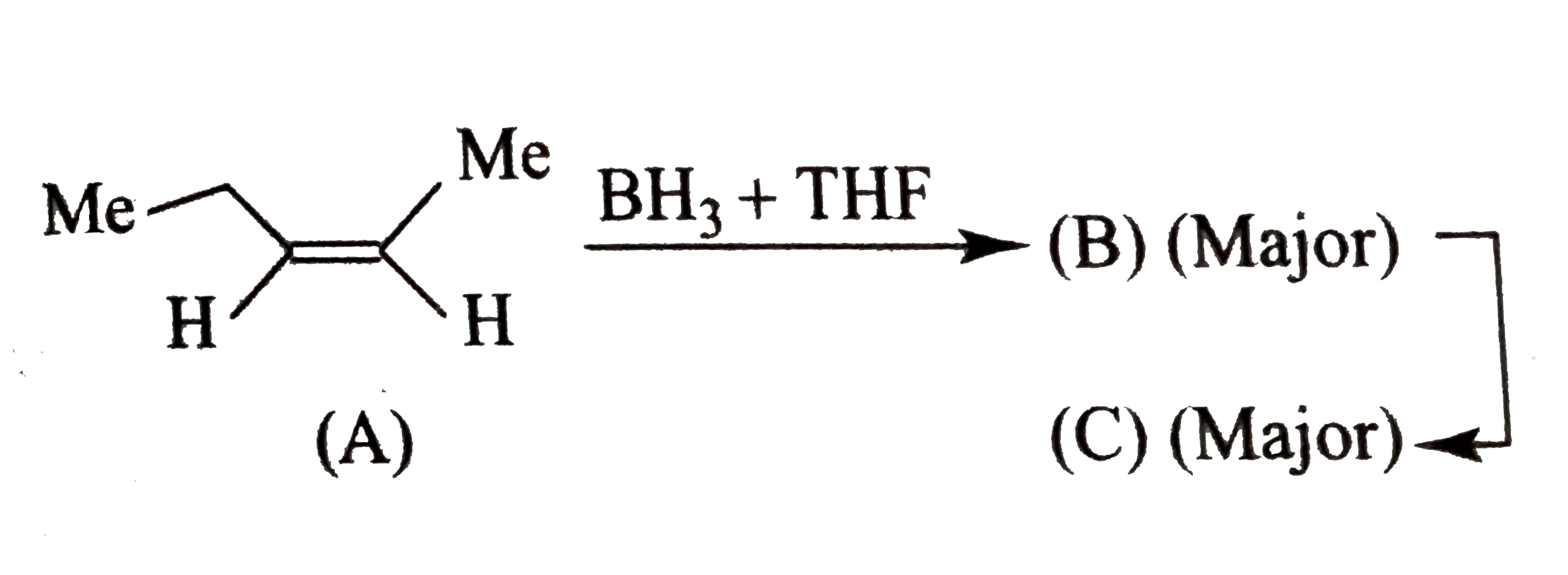(A)(C10H16)Reductiveozonolysis−−−−−−−−−−−→(B)(C5H8O)
Oxidationozonolysis−−−−−−−−−−−→(C)(C5H8O2)
(A) reacts with one equivalent of H2/Pd.
Give all the possible structures of (A),(B) , and (C) if all of them are non− resolvable.
To solve the problem, we need to identify the structures of compounds A, B, and C based on the given information about their molecular formulas and the reactions they undergo.
Step 1: Determine the structure of compound A (C10H16)
1. Calculate the degree of unsaturation:
The formula for calculating the degree of unsaturation (DU) is:
DU=(2×number of carbons)+2−number of hydrogens2
For compound A (C10H16):
DU=(2×10)+2−162=20+2−162=62=3
This indicates that compound A has 3 degrees of unsaturation, which can be due to a combination of double bonds and/or rings.
2. Identify possible structures:
Since compound A is a symmetrical alkene and has only one double bond, the remaining two degrees of unsaturation must be satisfied by rings. Possible structures for A could include a cycloalkene with a double bond. For example:
- A possible structure could be a bicyclic compound such as bicyclo(2.2.1)hept-2-ene.
Step 2: Determine the structure of compound B (C5H8O)
1. Reductive ozonolysis:
The reaction of compound A with reductive ozonolysis produces compound B (C5H8O). This means that the double bond in A is cleaved, resulting in the formation of an aldehyde or ketone.
- Given that B has the formula C5H8O, a possible structure for B could be 3-pentenal (an aldehyde).
Step 3: Determine the structure of compound C (C5H8O2)
1. Oxidative ozonolysis:
The oxidative ozonolysis of compound A produces compound C (C5H8O2). This reaction typically results in the formation of carboxylic acids or ketones.
- A possible structure for C could be 3-pentenoic acid.
Summary of Structures:
- Compound A (C10H16): A symmetrical bicyclic alkene, for example, bicyclo(2.2.1)hept-2-ene.
- Compound B (C5H8O): 3-pentenal (an aldehyde).
- Compound C (C5H8O2): 3-pentenoic acid (a carboxylic acid).
The formula for calculating the degree of unsaturation (DU) is:
DU=(2×number of carbons)+2−number of hydrogens2
For compound A (C10H16):
DU=(2×10)+2−162=20+2−162=62=3
This indicates that compound A has 3 degrees of unsaturation, which can be due to a combination of double bonds and/or rings.
Since compound A is a symmetrical alkene and has only one double bond, the remaining two degrees of unsaturation must be satisfied by rings. Possible structures for A could include a cycloalkene with a double bond. For example:
- A possible structure could be a bicyclic compound such as bicyclo(2.2.1)hept-2-ene.
The reaction of compound A with reductive ozonolysis produces compound B (C5H8O). This means that the double bond in A is cleaved, resulting in the formation of an aldehyde or ketone.
- Given that B has the formula C5H8O, a possible structure for B could be 3-pentenal (an aldehyde).
The oxidative ozonolysis of compound A produces compound C (C5H8O2). This reaction typically results in the formation of carboxylic acids or ketones.
- A possible structure for C could be 3-pentenoic acid.
- Compound A (C10H16): A symmetrical bicyclic alkene, for example, bicyclo(2.2.1)hept-2-ene.
- Compound B (C5H8O): 3-pentenal (an aldehyde).
- Compound C (C5H8O2): 3-pentenoic acid (a carboxylic acid).
Topper's Solved these Questions
- BOOK - CENGAGE CHEMISTRY ENGLISHCHAPTER - ALKENES AND ALKADIENESEXERCISE - linked Comprehension Type38videos
ALKENES AND ALKADIENES
- BOOK - CENGAGE CHEMISTRY ENGLISHCHAPTER - ALKENES AND ALKADIENESEXERCISE - Multiple Correct Answer Type41videos
ALKENES AND ALKADIENES
- BOOK - CENGAGE CHEMISTRY ENGLISHCHAPTER - ALKENES AND ALKADIENESEXERCISE - SOLVED Example62videos
ALKENES AND ALKADIENES
- BOOK - CENGAGE CHEMISTRY ENGLISHCHAPTER - ALKANES AND CYCLOALKANESEXERCISE - Archives13videos
ALKANES AND CYCLOALKANES
- BOOK - CENGAGE CHEMISTRY ENGLISHCHAPTER - ALKYNESEXERCISE - Exercises (Archives - Analytical and Desriptive Type)4videos
ALKYNES
Similar Questions
C8H10O3,H2O−−−−→C4H6O2 Acid (B), Identify (A) and (B) in the above reaction
View SolutionAn organic compound (A) (C8H14O) forms an oxime and gives a positive haloform reaction. On ozonolysis, it gives acetone and a compound (B) (C5H8O2) . (B) forms a dioxime and on subjecting to oxidation reaction gives an acid (C ) (C4H6O4). On treatment with excess of ammonia and strong heating, (C ) gives a neutral compound (D) (C4H5O2N). (D) on distillation with zinc dust forms pyrrloe. Suggest the possible structures of (A), (B), (C ), and (D). Explain the chemical reactions involved.
View Solution H2O2+ΘOH
H2O2+ΘOH
B and C are:View Solution(A)(C4H8O)H3O⊕−−−→(B)CrO3−−−−−→acetic acid(C)CH2N2−−−→Δ(D)
The compound 'D' isView SolutionAn unknown compound on ozonolysis to give acid C3H6O2 and a ketone C4H8O. From this information identify structure of unknown compound.
View SolutionCH3OH+C2H5OHH⊕−−→ Products
View SolutionC2H5O−O∣∣C−OC2H52MeMgBr−−−−−→(A). The product (A) formed can:
View SolutionC5H11Br+NaCN→AH3O+−−−→B+NaOHCaO−−→C
C' has the formula C5H12 which can give four structural isomeric monochloro derivative . What is the structure of C5H11Br ?View SolutionAn alkene (A)C16H16 on ozonolysis gives only one product (B)(C8H8O). Compound (B) on reaction with NH2OH followed by reaction with H2SO4,Δ gives N - methyl benzamide the compound 'A' is -
View SolutionRed precipitate Cu2Cl2←−−−−NH4OHP(C5H8)Ozonolysis−−−−−→2-Methylpropanoic acid + compound (Q) structure of P can be-
View Solution

